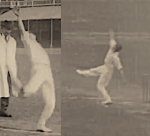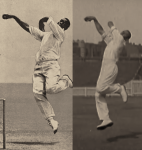I can only go by what the film information is telling me, I don't have photos of any of Pegler, Parker or Gilligan bowling and they're often what I'd use (though a hapless batsman does usually equal Sutcliffe), I have one other clip of Gilligan bowling and it does look a bit different, although it was after his bad injury. It doesn't explain that other clip that I linked though, where you clearly see the same fast bowler but the score shown at
0:58 doesn't match up to any of the two tests Parker played in. I am now a little bit inclined that you may be right, but that linked video is a big question mark. It wouldn't be the first time I messed up here - while making the collage I released that the bowler I'd said was Morkel in a 1927/28 clip in the HF thread was actually Geary, and they look nothing alike.
Also I don't think the slower bowler is bowling actual leg spin. Widen says that Pegler bowled medium, but with a 'quick break from leg', so it sounds like he was cutting the ball, and the wrist is straight.




